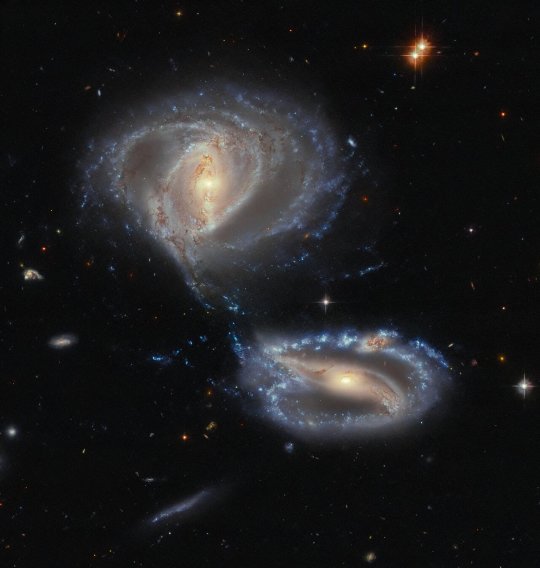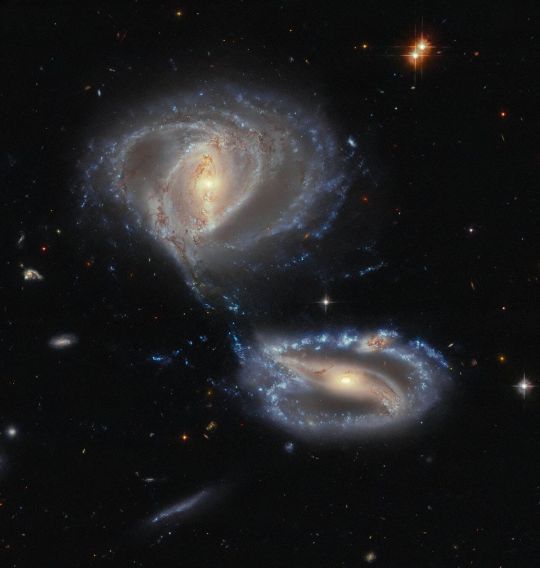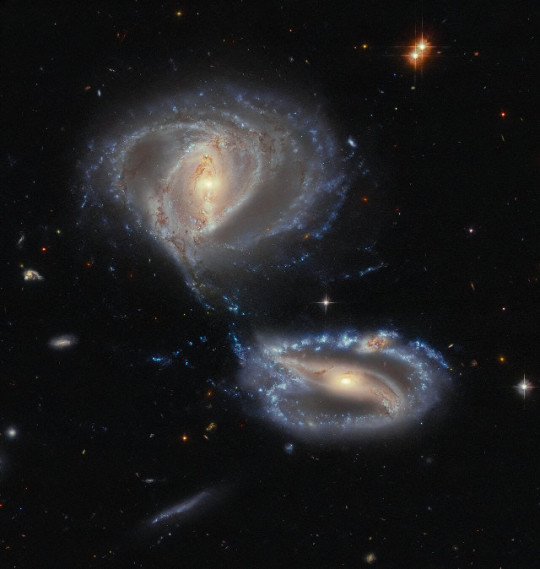#NGC 7733N
Text

Triple Merger
180 notes
·
View notes
Text

This striking image captures the interacting galaxy pair known as Arp-Madore 2339-661, so named because they belong to the Arp-Madore catalogue of peculiar galaxies. However, this particular peculiarity might be even odder than first meets the eye, as there are in fact three galaxies interacting here, not just two.
The two clearly defined galaxies are NGC 7733 (smaller, lower right) and NGC 7734 (larger, upper left). The third galaxy is currently referred to as NGC 7733N, and can actually be spotted in this picture if you look carefully at the upper arm of NGC 7733, where there is a visually notable knot-like structure, glowing with a different colour to the arm and obscured by dark dust.
Credit: ESA/Hubble & NASA
1K notes
·
View notes
Text

Hubble captures galaxy pair Arp-Madore 2339-661
This striking image from the NASA/ESA Hubble Space Telescope captures the interacting galaxy pair known as Arp-Madore 2339-661. The Arp-Madore catalog is a collection of peculiar galaxies, and this group's particular peculiarity might be odder than first meets the eye, as there are three galaxies interacting here, not just two.
The two clearly defined galaxies are NGC 7733 (smaller, lower right) and NGC 7734 (larger, upper left). The third galaxy is currently referred to as NGC 7733N and is visible if you look carefully at the upper arm of NGC 7733. There you can spot knot-like structure, glowing with a different color than the arm and obscured by dark dust. This could easily pass as part of NGC 7733, but analysis of the velocities (speed and direction) involved reveals that this knot has a considerable additional redshift.
This means it is very likely its own entity and not part of NGC 7733. This galaxy group presents one of the many challenges that observational astronomers face: working out whether an astronomical object really is just one, or multiple objects, one lying in front of another as seen from Earth's perspective.
All three galaxies lie quite close to each other, roughly 500 million light-years from Earth in the constellation Tucana, and, as this image shows, they are interacting gravitationally with one another. In fact, some science literature refers to them as a 'merging group,' which means they will ultimately become a single entity.
20 notes
·
View notes
Text

An image captured by the Hubble Space Telescope depicts Arp-Madore 2339-661, an object that until not many years ago was considered a pair of interacting galaxies, cataloged as NGC 7733 (bottom right) and NGC 7734 (top left). However, observing the upper arm of NGC 7733, it's possible to see a sort of large knot of a color different from the predominant blue which is actually a dwarf galaxy, now cataloged as NGC 7733N. The consequence is that the interaction taking place is what some call a merging group. Mergers between two galaxies are normal but sometimes there are more galaxies and in this case, there are three of them that show signs of having active galactic nuclei.
#astronomy#galaxies#galaxy merger#Arp-Madore 2339-661#active galactic nuclei#supermassive black holes
5 notes
·
View notes
Link
Arp-Madore 2339-661, initially thought to be a pair of interacting galaxies, is in fact a trio comprising NGC 7733, NGC 7734, and NGC 7733N. Located...
6 notes
·
View notes
Text
Captan extraña colisión entre tres galaxias
El telescopio espacial @NASAHubble capta una extraña colisión galáctica triple entre NGC 7733, NGC 7734 y NGC 7733N.
Agencias/Ciudad de México.- Esta singular imagen del Telescopio Espacial Hubble de NASA/ESA captura el par de galaxias en interacción conocido como Arp-Madore 2339-661.
El catálogo de Arp-Madore es una colección de galaxias peculiares, y la peculiaridad particular de este grupo podría ser más extraña de lo que parece a primera vista, ya que aquí hay tres galaxias interactuando, no solo dos.
Las…

View On WordPress
0 notes
Text

Hubble Space Telescope reveals an unexpected galaxy trio
A new image from the Hubble Space Telescope reveals a galaxy overshadowed by its larger, merging companions.
Located roughly 500 million light-years from Earth lies a galactic pair collectively known as Arp-Madore 2339-661. The two galaxies are in the process of merging, according to a statement from the European Space Agency. One galaxy is known as NGC 7733 — the smaller galaxy seen in the lower right — and the other is NGC 7734 — the larger galaxy in the upper left.
However, hidden in the star-studded spiral arm of NGC 7733 is yet another galaxy, referred to as NGC 7733N. Until now, this realm has appeared to be obscured by dark dust. Using the Hubble data, however, astronomers were able to discern a knot-like structure with a notable red glow, standing out in comparison to the bright blue stars of NGC 7733.
0 notes
Link
2 min read Hubble Captures a Galactic Dance NASA’s Hubble Space Telescope captures the dance of interacting galaxies in Arp-Madore 2339-661 (NGC 7733, NGC 7734). ESA/Hubble and NASA, J. Dalcanton, Dark Energy Survey/DOE/FNAL/NOIRLab/NSF/AURA; Acknowledgement: L. Shatz This striking image from the NASA/ESA Hubble Space Telescope captures the interacting galaxy pair known as Arp-Madore 2339-661. The Arp-Madore catalog is a collection of peculiar galaxies, and this group’s particular peculiarity might be odder than first meets the eye, as there are three galaxies interacting here, not just two. The two clearly defined galaxies are NGC 7733 (smaller, lower right) and NGC 7734 (larger, upper left). The third galaxy is currently referred to as NGC 7733N and is visible if you look carefully at the upper arm of NGC 7733. There you can spot knot-like structure, glowing with a different color than the arm and obscured by dark dust. This could easily pass as part of NGC 7733, but analysis of the velocities (speed and direction) involved reveals that this knot has a considerable additional redshift. This means it is very likely its own entity and not part of NGC 7733. This galaxy group presents one of the many challenges that observational astronomers face: working out whether an astronomical object really is just one, or multiple objects, one lying in front of another as seen from Earth’s perspective! All three galaxies lie quite close to each other, roughly 500 million light-years from Earth in the constellation Tucana, and, as this image shows, they are interacting gravitationally with one another. In fact, some science literature refers to them as a ‘merging group,’ which means they will ultimately become a single entity. Text credit: European Space Agency Media Contact: Claire AndreoliNASA’s Goddard Space Flight Center, Greenbelt, [email protected] Share Details Last Updated Oct 27, 2023 Related Terms Galaxies Goddard Space Flight Center Hubble Space Telescope Missions Spiral Galaxies The Universe Keep Exploring Discover More Topics From NASA Stars Stories Galaxies Stories Exoplanets Our Solar System
0 notes
Text

Un'immagine catturata dal telescopio spaziale Hubble ritrae Arp-Madore 2339-661, un oggetto che fino a non molti anni fa era considerato una coppia di galassie interagenti, catalogate come NGC 7733 (in basso a destra) e NGC 7734 (in alto a sinistra). Tuttavia, osservando il braccio superiore di NGC 7733 è possibile vedere una sorta di grande nodo di colore diverso dal blu predominante che in realtà è una galassia nana, ora catalogata come NGC 7733N. La conseguenza è che l'interazione in atto è quella che alcuni chiamano una fusione di gruppo. Fusioni tra due galassie sono normali ma a volte c'è una quantità superiore di galassie e in questo caso ce ne sono tre che mostrano segni di avere nuclei galattici attivi.
#astronomia#galassie#Arp-Madore 2339-661#fusione galattica#nuclei galattici attivi#buchi neri supermassicci
0 notes